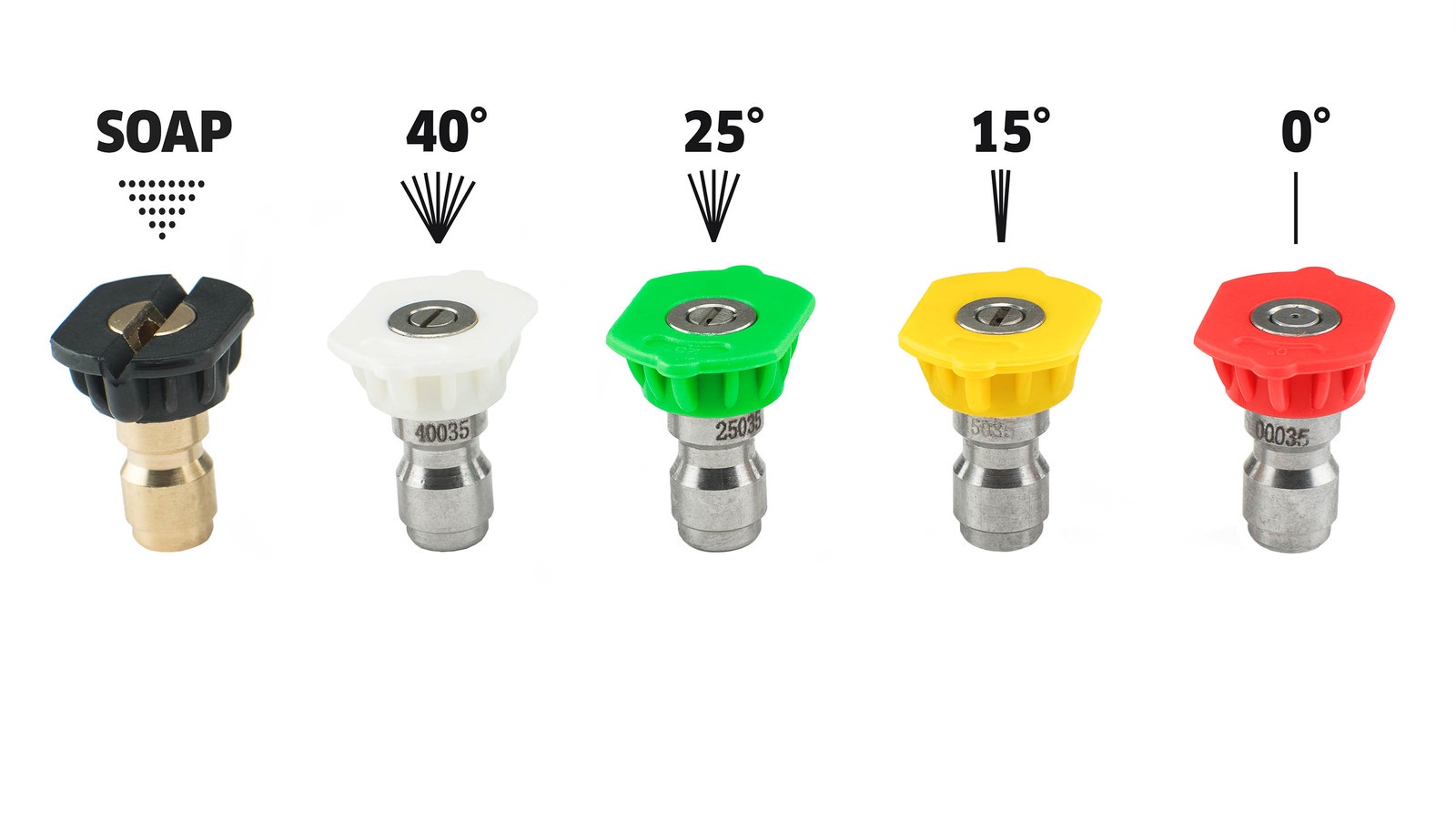
If you’ve ever tried pressure washing and felt like your results weren’t quite right — too weak, too harsh, or completely missing the mark — there’s a good chance the problem wasn’t the washer itself, but the nozzle. 😬💦
Choosing the right nozzle for your pressure washer isn’t just about blasting water. It’s about using the proper tool for the job so you clean effectively, avoid damage, and get professional-grade results — even if you’re a DIYer or just starting a power washing business. 🏠✨
In this article, we’ll walk you through:
- The types of nozzles (and what those confusing colors mean)
- How to match nozzles to surfaces and tasks
- Mistakes to avoid that could damage your property
- Tips for making your pressure washing smarter, faster, and safer 🧠💧
🎨 Understanding Nozzle Colors and Angles
Most pressure washer nozzles are color-coded — and no, it’s not just for style. Each color represents a specific spray angle, which controls the intensity and spread of water.
Here’s a quick breakdown:
| Color | Angle | Description | Use Case |
|---|---|---|---|
| 🔴 Red | 0° | Pinpoint stream, most intense pressure | Tough stains on concrete, rust |
| 🟠 Orange | 15° | Narrow spray, strong impact | Paint removal, heavy-duty cleaning |
| 🟡 Yellow | 25° | Medium-width spray | General purpose (driveways, decks) |
| 🟢 Green | 40° | Wide spray, gentle pressure | Cars, windows, wood surfaces |
| ⚪ White | 60° | Very wide spray, low pressure | Rinsing, soap application |
| ⚫ Black | Soaper | Applies detergent at low pressure | Pre-cleaning with soap |
🎯 Rule of thumb: The wider the spray angle, the gentler the stream — and the safer it is for delicate surfaces.
🧼 Nozzle vs. Turbo Tip: What’s the Difference?
You may have also heard of turbo nozzles (sometimes called rotary nozzles). These bad boys spin a tight zero-degree stream in a circular motion, which gives you the intensity of a red tip, but with broader coverage.
💡 Turbo nozzles are great for:
- Caked-on mud
- Moldy patios
- Greasy driveways
⚠️ But be careful — they’re too aggressive for wood, siding, or glass.
🏡 Matching Nozzles to the Job
Let’s get practical. Here’s a breakdown of common tasks and which nozzle is ideal for each:
✅ Cleaning Concrete (Driveways & Sidewalks)
- Recommended: 15° (Orange) or Turbo Nozzle
- Why: You need high pressure to remove oil stains, grime, and algae
✅ Washing a Car or Truck
- Recommended: 40° (Green) or 60° (White)
- Why: Too much pressure can damage paint and trim. Use a soaping nozzle first.
✅ House Siding (Vinyl or Stucco)
- Recommended: 25° (Yellow) or 40° (Green)
- Why: A soft wash approach is safer — especially for older homes
✅ Deck or Fence (Wood or Composite)
- Recommended: 25° (Yellow), used carefully
- Why: Too much pressure can gouge wood. Keep the tip at least 12″ away.
✅ Pre-Soaking Surfaces with Detergent
- Recommended: Black (Soaper)
- Why: Applies soap gently so it sticks before rinsing
Browse Amazon Here For Top Rated Power Washers And Accessories
💡 Tips for Using the Right Nozzle Correctly
Even with the correct nozzle, technique matters. Here are some key tips to remember:
🧍♂️ Watch Your Distance
Start at a distance of 2–3 feet from the surface and slowly move closer. Don’t start too close — that’s a recipe for etching or damage. 😬
🧼 Test Before You Commit
Always test your nozzle on an inconspicuous spot, especially for wood, stucco, painted surfaces, or vehicles.
↕️ Use a Consistent Sweeping Motion
Keep the nozzle moving! Holding it in one place for too long can leave marks or strip paint.
🌊 Let the Soap Do the Work
When using detergent, apply with the black tip, let it dwell, and then rinse with a wider-angle tip. Don’t rely on pressure alone.
❌ Common Nozzle Mistakes to Avoid
Avoid these rookie mistakes that could cost you time, money, or damage:
- Using a red tip on anything but concrete
(seriously — this one causes more destruction than it’s worth!) - Applying pressure to windows or vents
unless you’re using a wide, low-pressure tip - Forgetting to clean your nozzles
Dirt and grit inside the tip can affect spray patterns or cause clogging - Using mismatched tips with PSI levels
Not all nozzles are created equal. Some are designed for low PSI machines — others for high PSI models.
🧠 Always check your pressure washer’s specs and follow the manufacturer’s guidelines.
🛠️ How to Maintain Your Nozzles
Want your nozzles to last and work consistently?
Here’s how to care for them:
- Rinse after each use
- Use a pin or nozzle cleaning tool to remove buildup
- Store them in a labeled holder or container
- Replace worn-out nozzles every season (if you use them heavily)
💧 A clean nozzle = consistent pressure and better results every time.
🧽 Final Thoughts
The humble pressure washer nozzle is often overlooked — but it’s arguably the most important part of your setup. Whether you’re restoring a driveway, detailing a car, or soft-washing a home, choosing the right nozzle can mean the difference between a clean surface and a costly mistake.
Remember:
- Match the angle to the task
- Use a gentler tip than you think you need (you can always go stronger)
- Practice good technique
- And when in doubt — test it out! 🔄
👨🔧 The more you learn to master your nozzles, the more efficient, professional, and profitable your power washing work becomes.
Browse Amazon Here For Top Rated Power Washers And Accessories



